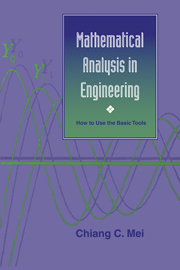Book contents
- Frontmatter
- Contents
- Preface
- Acknowledgments
- 1 Formulation of physical problems
- 2 Classification of equations with two independent variables
- 3 One-dimensional waves
- 4 Finite domains and separation of variables
- 5 Elements of Fourier series
- 6 Introduction to Green's functions
- 7 Unbounded domains and Fourier transforms
- 8 Bessel functions and circular boundaries
- 9 Complex variables
- 10 Laplace transform and initial value problems
- 11 Conformal mapping and hydrodynamics
- 12 Riemann–Hilbert problems in hydrodynamics and elasticity
- 13 Perturbation methods – the art of approximation
- 14 Computer algebra for perturbation analysis
- Appendices
- Bibliography
- Index
14 - Computer algebra for perturbation analysis
Published online by Cambridge University Press: 05 June 2012
- Frontmatter
- Contents
- Preface
- Acknowledgments
- 1 Formulation of physical problems
- 2 Classification of equations with two independent variables
- 3 One-dimensional waves
- 4 Finite domains and separation of variables
- 5 Elements of Fourier series
- 6 Introduction to Green's functions
- 7 Unbounded domains and Fourier transforms
- 8 Bessel functions and circular boundaries
- 9 Complex variables
- 10 Laplace transform and initial value problems
- 11 Conformal mapping and hydrodynamics
- 12 Riemann–Hilbert problems in hydrodynamics and elasticity
- 13 Perturbation methods – the art of approximation
- 14 Computer algebra for perturbation analysis
- Appendices
- Bibliography
- Index
Summary
While programming languages such as FORTRAN are designed for numerical computations, a number of them, e.g., MACSYMA, MAPLE, MATHEMATICA, REDUCE and THEORIST, have been developed to handle symbolic manipulations. With these languages one can use the computer to manipulate algebraic and trigonometric operations, differentiation and integration, Taylor series expansions, Laplace transform, and the solution of simple ordinary differential equations. When repetitive and lengthy manipulations are needed, these symbolic languages are extremely useful for speed and accuracy. In this chapter we first introduce some basic commands of MACSYMA and then illustrate their use for perturbation analysis. Only the bare essentials are introduced to get the reader started. More proficient users of the computer may very well wish to consult the MACSYMA manuals in order to find more shortcuts. There are also a few books devoted exclusively to the basics and applications of MACSYMA. Computer Algebra in Applied Mathematics – An Introduction to MACSYMA by R.H. Rand (1984) and Variational Finite Element Methods – A Symbolic Computation Approach by A.I. Beltzer (1990) are both helpful.
Getting started
MACSYMA can be installed on a variety of computers. On each the entry protocol may be slightly different. On a personal computer (PC) you simply enter WINDOWS, point the icon at the MACSYMA logo and click the mouse. After a short wait a few lines of trademark information appear on the monitor screen, followed by the first command line, (c1)
All the command lines are preceded by the letter c and numbered consecutively.
- Type
- Chapter
- Information
- Mathematical Analysis in EngineeringHow to Use the Basic Tools, pp. 408 - 446Publisher: Cambridge University PressPrint publication year: 1995



